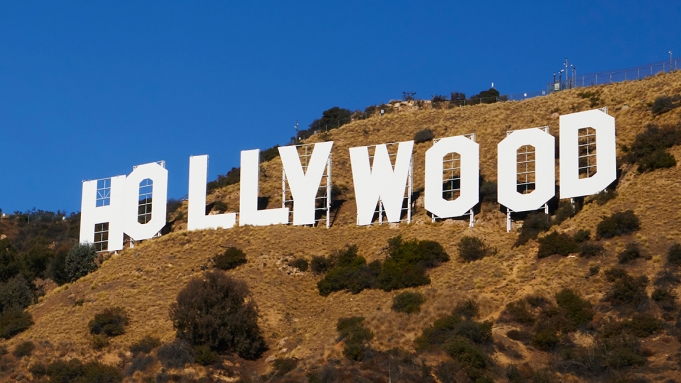How Hollywood is Slowly Destroying Itself
The famous Hollywood sign basking in the sun of Los Angeles, California
March 4, 2022
Over the 134 years that the art of cinema has existed, there have been hundreds of thousands of people that have brought their visions and creative ideas ‘to the silver screen’ as a way to express themselves. This was, at least, the original intention of filmmaking. Back when filmmaking started, Hollywood didn’t even exist. Hollywood was formed in 1903, merged with Los Angeles in 1910, and shortly afterwards it became the main location of the American film industry. As films became more and more marketable to a general audience, the capitalistic value of cinema overshadowed everything else. Going to the cinema became a very popular way to spend an evening, and people started going to the movies. The art form became increasingly industrialized, and Hollywood was born. The concept of ‘producing a film’ grew. Soon enough, film became a rich man’s game. Films like Intolerance (1916) suddenly had massive budgets, or at least too massive to be considered a mere passion project. These types of films simply have the intent to make money instead, and thus the concept of the blockbuster was formed. This is now an integral part of Hollywood that’s slowly consuming the media world. The idea of the blockbuster wasn’t widespread and popularized until Jaws (1975). However, if you look back at the films of the silent era, you can tell that some of those films were clearly made to sell tickets at the box office, rather than trying to invoke real feeling in the audience, like Rashomon (1950). Films that question, explore, or challenge our current ways of thinking are very hard to come by these days because of the blockbuster. Movie studios tend to lean towards blockbusters rather than these types of films.
To some extent, this is fine. I would even say that it’s a good thing, because it keeps theaters in business and film studios have more money. If the industry was mainly arthouse films, then there would definitely be less interest overall in film. It’s not like the movie studios don’t have enough money, but with the money they make from blockbusters they could take a chance with something less mainstream like Licorice Pizza (2021), or let directors create their true vision for a film like 1917 (2019). However, the main film studios (Disney, Warner Bros, Universal, etc.) aren’t very likely to do something like this, because why would you give money to a director for a film of their artistic vision when you could produce the next Marvel movie and make a billion dollars? Logically, you take the billion dollar option every time, hence why we get multiple superhero films from each studio every year.
Martin Scorsese, who infamously stated that Marvel films were like theme parks in an interview with Empire magazine, says this best in his follow-up piece for the New York Times: “In the past 20 years, as we all know, the movie business has changed on all fronts. But the most ominous change has happened stealthily and under cover of night: the gradual but steady elimination of risk.”
To clarify, I don’t hate Marvel movies. I’m actually a big fan of the comics and really enjoy seeing them come to life on the big screen. However, ever since the massive success of the MCU, every studio has realized that franchises can make you a billion bucks a pop, and have tried to set up their own ‘cinematic universes,’’, the concept that every movie in the franchise is connected and builds up towards a main plotline.
Now, it’s not like the concept of media franchises originated with Marvel. Since even the mid 1900s we’ve seen the likes of James Bond, Sherlock Holmes, and Star Wars, all of which follow similar plot lines with each movie and are more or less popcorn flicks. Like I said above, these can be quite good for the industry since it boosts theater ticket sales and helps the industry drastically. The inherent problem with these films is that they are the only films the general audience goes to the theaters to see. Why would one choose to see Nightmare Alley (2021) in theaters when you could watch the new Spider-Man: No Way Home (2021) or The Matrix Resurrections (2021)? On average, people go to the theaters just a couple of times a year, so logically they want to see something that everybody is talking about, like Scream (2022).
Making a movie is, from a business perspective, an investment. You want to invest in a movie that you know will do well at the box office and will appeal to a general audience, and big blockbusters check both of those boxes. The movie doesn’t even have to be good to succeed;, F9: The Fast Saga (2021) grossed a whopping 726.2 MILLION dollars worldwide at the box office, at a time when lots of people were still scared to go to theaters because of COVID-19. That is 9.2 times the amount that Lady Bird (2017) grossed worldwide, 14.8 times the amount Whiplash (2014) grossed worldwide, and as of the writing of this article (January 25, 2022), 49.7 times the amount that Licorice Pizza (2021) grossed worldwide. You could add all three of those up and not even get a tenth of the money that F9: The Fast Saga made. Hollywood knows that franchises are more commercially successful and name recognition will immediately trigger audiences to go see the movie, regardless of quality. It’s unfortunate for arthouse films, but that is what the entertainment industry has become.
Moviemaking is both an art form and a business, and the capitalistic business aspect has taken over the minds of producers and studios. In these regards, Hollywood has truly lost its real identity, in that movies being made for the sake of creativity and innovation aren’t practical in Hollywood anymore. Producers aren’t looking for the creativity that film used to be entirely about, but for the safest investment possible. As terrible or mindless as the film that investment may be, they still pay off, and will continue to pay off.
Each and every person has their own opinions, and the same can be said for viewing art. Some people find solace in mindless blockbusters, while some find them intolerable and well, mindless. Some cinema wasn’t meant to appeal to everybody, and makes a valid case for its existence other than money, while some was designed to be as appealing and passive to as large an audience as possible. This raises the fundamental question, is the goal of cinema to be entertaining, or to explore/challenge the wonders of life as a genuine artform? That is entirely up to the individual, because we all view art differently and always will.
















Jim • Mar 8, 2024 at 3:12 PM
The real issue underneath all of this is very poorly understood but extremely destructive. And that is the issue of media ownership.
There’s always going to be friction between art and commerce. That hasn’t caused the problem we’re facing today Something else changed, and that was The Telecommunications Act of 1996.
This bill removed all restriction on media ownership. Suddenly almost the entire media was bought up and consolidated. When the dust settled, 5 multinational corporations controlled 90% of what people heard, saw, read and watched. Back 1980’s watchdog groups voiced concern over the fact that only 50 companies controlled the majority of the media. But at 5, it might as well be owned by one. Democracy can’t exist under these conditions. And neither can healthy markets and industry. There must be vibrant competition to drive risk, innovation and creativity.
With companies controlling so much of audience share, the focus shifts from an audience-focused model to a producer centered model. Studios try to make fewer films and try to get more people to see them, in a sort of “one-size-fits-all” model. That’s why we see so many films marketed to adults and yet also are perfect for young children. Content creators now “push” content onto the audience rather than trying to connect with viewers and competing to earn their small portion of the market. We need to reverse these laws and break up these corporations.
Joe • Sep 1, 2022 at 9:47 PM
Fact